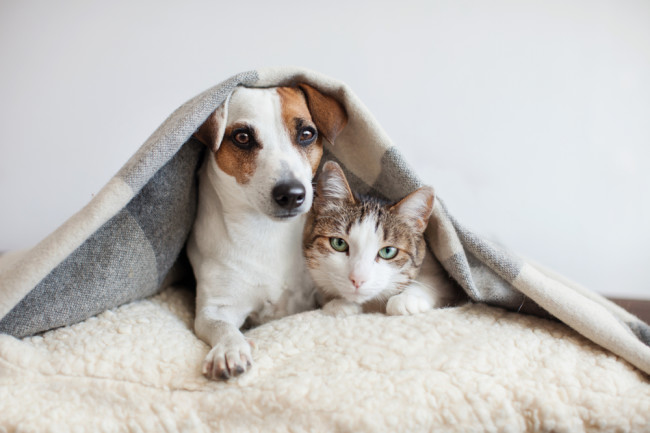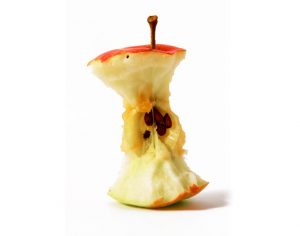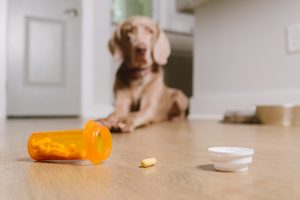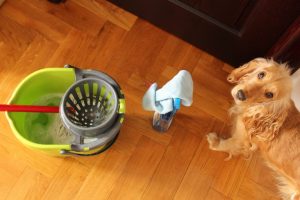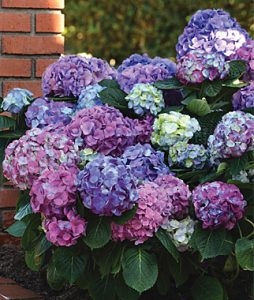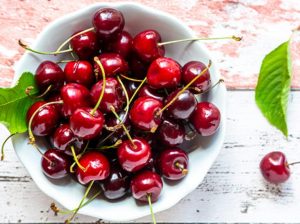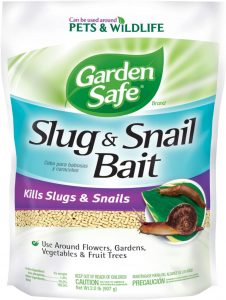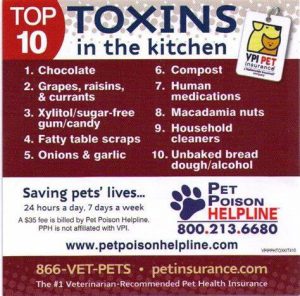While the list is long, we wanted to know: What are the most dangerous — and perhaps unsuspected — things in the kitchen readily available to our cat or dog that we may not know about? What about the toxins lurking in our own backyards? Check out the list below to learn how to better protect our pets.
Common signs of poisoning: Signs of poisoning can vary widely depending on the type of poison that your dog or cat is exposed to, but may include: Vomiting, Diarrhea, Lethargy, Drooling, Twitching, Tremors, and Seizure. Please also know that your pet will most often find a hiding spot.
How fast will my cat or dog show signs: It can take a while for the toxin to cause the dog or cat to show any physical signs that something is wrong, even though damage may be occurring underneath the surface. Some poisoning symptoms will show up immediately after ingestion. Others may take several hours up to 2 to 5 days.
What to do if you suspect your pet has ingested something harmful: Call or take your pet to your veterinarian or a 24 hour emergency clinic immediately. If at all possible, bring a sample of what your pet has ingested. You can also call the PET POISON HELPLINE: 1-800-213-6680.
LET’S LOOK AT SOME COMMON TOXINS RIGHT INSIDE OUR HOMES:
1.Caffeine:

Caffeine contains chemicals toxic to cats and dogs and ingestion can be life-threatening. Caffeine can be found in many other products than just regular coffee, including decaffeinated coffee, tea, cookies, pudding, cocoa, breakfast cereals, chocolate, soft drinks, energy drinks, coffee- or chocolate-flavored yogurt or ice cream, pain relievers, diet pills and even some caffeine-infused energy foods like oatmeal and sunflower seeds.
Even a small amount of caffeine can affect a pet’s heart, nervous system and gastrointestinal tract. According to the Pet Poison Helpline, a small amount of caffeine can cause death in small dogs and cats so be sure to dispose of coffee grounds, coffee pods and food containers where your pet cannot get to them.
2. Chocolate:  In addition to containing caffeine, chocolate also contains theobromine, which is hazardous to cats & dogs. Theobromine is found in all kinds of chocolate but more so in the darker varieties. Dogs and cats are not able to metabolize theobromine as quickly as we can and this can lead to a buildup of that toxic substance in their bodies. Your pet might display symptoms like vomiting, diarrhea, insatiable thirst and disrupted heart rhythms. It could also be fatal in some circumstances.
In addition to containing caffeine, chocolate also contains theobromine, which is hazardous to cats & dogs. Theobromine is found in all kinds of chocolate but more so in the darker varieties. Dogs and cats are not able to metabolize theobromine as quickly as we can and this can lead to a buildup of that toxic substance in their bodies. Your pet might display symptoms like vomiting, diarrhea, insatiable thirst and disrupted heart rhythms. It could also be fatal in some circumstances.
3. Grapes, Raisins & Currants: 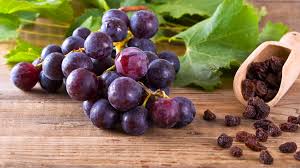 Grapes and raisins can be toxic to both cats and dogs. They cause the sudden development of kidney failure in some pets. Signs of toxicity can be seen within 12 hours of ingestion, with vomiting being the first symptom. Other signs that may occur within 24 hours include: Diarrhea, Lethargy, Lack of appetite, Decreased urination, Weakness, Abdominal pain, and Possibly death.
Grapes and raisins can be toxic to both cats and dogs. They cause the sudden development of kidney failure in some pets. Signs of toxicity can be seen within 12 hours of ingestion, with vomiting being the first symptom. Other signs that may occur within 24 hours include: Diarrhea, Lethargy, Lack of appetite, Decreased urination, Weakness, Abdominal pain, and Possibly death.
4. Apple Cores:
While apple slices are safe, the core and seeds of an apple are not! Apple seeds are poisonous to dogs, cats, and people alike and contain trace amounts of cyanide. Cyanide is a chemical that can cause hypoxia or lack of oxygen delivery to the body. If your dog or cat swallows a few apple seeds-most likely it won’t cause harm, but it is better to not risk it at all. Make sure to remove any seeds before feeding your dog apples.
5. Xylitol/Sugar-free human food/Gum/Candy: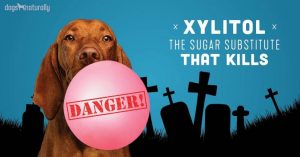
Xylitol is a sugar substitute commonly used in sugarless food, yogurts, jello, and a variety of nut butters, including some peanut butters. Xylitol can also be found in a variety of toothpastes. The ingestion of Xylitol causes your dog’s insulin level to rapidly increase, leading to a quick decrease of its blood sugar level. This results in hypoglycemia (low blood glucose), which can badly affect your dog’s liver. The symptoms of liver failure include lethargy, vomiting, seizures and coordination issues. Seek treatment immediately if your dog is having any symptoms because the results could potentially be fatal. As for cat’s – Xylitol doesn’t seem to affect them negatively in the same way, according to a study conducted in June of 2017 by the Journal of Veterinary Pharmacology and Therapeutics.
6. Fatty Table Scraps & Grease:
As much as your dog would love to chow down on the leftover fat trimmed from your steak, it’s a bad idea to give these to him. Avoid sharing fat-filled items like fast food, fried foods, foods cooked in grease, high fat dairy items, processed meats and junk food with your cat and dog. These items can cause severe gastrointestinal upset in dogs. Further, pancreatitis, which can be fatal if left untreated, has been linked to the ingestion of fatty foods. With cat’s – it can cause digestive upset & vomiting.
7. Onions/Garlic/Chives:

Close members of the allium family (onions, garlic, leeks, shallots, chives, scallions) and concentrated versions of them (garlic powder, dehydrated onions, onion soup mix) contain the compound thiosulphate. In dogs & cats, thiosulphate causes hemolytic anemia. It attacks the red blood cells, causing them to burst. Signs of allium toxicity may not be apparent for three to five days after ingestion. They include vomiting, oral irritation, drooling, diarrhea, abdominal pain, lethargy, pale gums, weakness, elevated heart or respiratory rate, exercise intolerance and fainting.
8. Cooked Bones:

Although this isn’t a toxin- it is still dangerous to our dogs (and cats). Just say NO to cooked bones! Why? Just too many risks involved. The cooking process strips away most of the natural moisture in the bones, making them extremely brittle. When your pet bites into these bones, they splinter. These splinters can damage your pet’s teeth or get stuck in their throats and become a choking hazard. The splinters can even puncture your pet’s digestive tract or intestine. A safer and healthier option would be to offer raw bones or bone-shaped treats.
9. Cheese/milk:

Dogs & cats lack the enzyme that can break down milk and milk products (like butter, cheese, curd) and many who are actually lactose intolerant. Cheese has a high-fat content that could also lead to pancreatitis in dogs. Avoid sharing your foods with your cat or dog to keep on the safe side – like that yummy cheeseburger they were eyeing!
10. Unbaked bread dough/alcohol:
While most of us know alcohol is bad for our pets, there are some who think it’s funny to share a beer with them. According to the Pet Poison Helpline, alcohol poisoning in pets is all too common. You may be surprised by the following items that all contain alcohol: Pure vanilla and almond extracts, certain brands of Dijon mustard, wine vinegar, wine-flavored cheeses, certain whipped creams, marinara sauces prepared with wine, chocolate truffles that may contain rum or bourbon, rum-soaked fruit cakes and unbaked dough. When the yeast in the unbaked dough ferments in your pet’s stomach, it produces carbon dioxide and alcohol which is then rapidly absorbed into the bloodstream. Ingestion of alcohol can cause dangerous drops in blood sugar, blood pressure and body temperature. Intoxicated animals can experience seizures and respiratory failure.
11. Nuts:
Do not feed your dog or cat nuts or any foods that may contain nuts. Macadamia nuts can cause serious symptoms in your pet that can last up to two days, including rear leg weakness, fever, tremors, and pain. Moldy walnuts, hickory nuts and pecans contain the toxin juglone, which can cause seizures and other neurological symptoms. Almonds, pistachios, and non-moldy walnuts, pecans and hickory nuts can cause gastrointestinal distress or blockage in the throat or intestinal tract.
One of the most dangerous rooms of the house with regard to accidental poisonings is the bedroom, since many medications are left on a nightstand. Many adult dogs and teething puppies sleep in the bed with their humans, and thus have easy access to the drugs on the nightstand. Even cats have easy access although they aren’t as easily tempted as a dog is. Here are a few common medications that are very harmful to dogs and cats. Aspirin, Ibuprofen, Naproxen, Indomethacin, Acetaminophen, Xanax, Ambien, Ace inhibitors, Beta Blockers, Adderall. If your pet should ingest ANY medications, call the Pet Poison Hotline and keep the bottle on hand. The vast majority of these accidental intoxications can be successfully managed with early treatment. For poisonings, the best outcomes involve seeking immediate advice from your veterinarian followed by aggressive, proactive treatment.
13. Household Cleaners: Anti-freeze, Oven Cleaners, or Dishwasher detergents–
Also known as alkaline substances, oven cleaners and automatic dishwasher detergents have little odor or taste, making them easier to consume by curious pets. Those convenient dishwasher pods are often targeted by pets— and children. Severe injury to the eyes, skin, gastrointestinal tract and respiratory system can be seen and require immediate decontamination, medication and supportive care by a veterinarian. Anti-freeze contains glycol, which has a sweet taste that is very attractive to animals. Glycol is extremely toxic causing kidney failure that is often fatal in just a few days. If a cat or small dog walks through a puddle of it, and then licks its paws, it can ingest enough antifreeze to cause death.
What are you mopping your floor with? Make sure it isn’t toxic to your pet! The National Center for Health Sciences says “… perhaps the most serious exposure is to modern household cleaners, which may contain a number of proven and suspect causes of cancer.” Cleaning products with ingredients such as bleach, ammonia, chlorine, glycol ethers or formaldehyde can put pets at risk for cancer, anemia, liver and kidney damage. Even when the toxic cleaners are put away and closed, the vapors left behind can continue to harm both us and our pets.
14. Essential Oils:
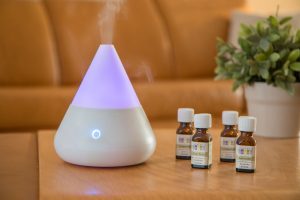
Essential oils can be harmful to both cats and dogs. Before using any essential oils (directly on your pet or in a diffuser) please make sure it is safe. The following are essential oils that can be toxic to our pets, including (but not limited to):
- Anise, Birch, Bitter Almond, Boldo, Calamus, Camphor, Cassia, Chenopodium, Clove, Garlic, Cinnamon (cats only), Eucalyptus (cats only), Goosefoot, Horseradish, Hyssop, Juniper, Lavender (cats only), Lemon (cats only), Mugwort, Mustard, Oregano, Pennyroyal, Peppermint (cats only), red or white Thyme, Rue, Santolina, Sassafras, Savory, Spruce (cats only), Tansy, Tea Tree, Terebinth, Thuja, Wintergreen, Wormwood, Yarrow
TOXINS IN OUR BACKYARD
Our backyards are full of plants, trees, and other wildlife – and you may have never questioned if any of these things could be harmful to our own pets. Are you a lover of house plants and have many sitting around your home?
Please review the list below.
1. Cane Toad: The cane toad, also known as the bufo toad, is a poisonous amphibian and if provoked, can produce a milky white toxin on its back. If a pet bites, licks or even sniffs a cane toad, it could become sick and, if not treated, could die as in little as 15 minutes according to the Florida Fish and Wildlife Commission. Some common symptoms of poisoning are: excessive drooling, extremely red gums, head-shaking, crying, loss of coordination, and convulsions. What They Look Like:
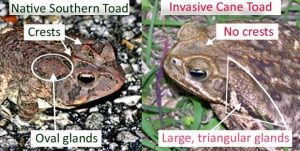 Cane Toads have warty skin and are tan to reddish-brown, dark brown or gray, and their backs are marked with dark spots. They also have large, triangular parotoid glands on their shoulders that secrete that milky toxin. Native toads will have an OVAL parotoid gland and they have ridges or crests on top of their head (cane toads do not). See photo for the difference. Cane toads also have un-webbed front hands and webbed back toes. What to do if you’re pet comes in contact? If your pet comes in contact with a cane toad, use a damp cloth or towel and wipe the inside of the dog’s mouth to make sure no toxins were swallowed. Contact your veterinarian ASAP or take your pet to the vet! Dog droppings should be picked up as cane toads are attracted to proteins in the droppings.
Cane Toads have warty skin and are tan to reddish-brown, dark brown or gray, and their backs are marked with dark spots. They also have large, triangular parotoid glands on their shoulders that secrete that milky toxin. Native toads will have an OVAL parotoid gland and they have ridges or crests on top of their head (cane toads do not). See photo for the difference. Cane toads also have un-webbed front hands and webbed back toes. What to do if you’re pet comes in contact? If your pet comes in contact with a cane toad, use a damp cloth or towel and wipe the inside of the dog’s mouth to make sure no toxins were swallowed. Contact your veterinarian ASAP or take your pet to the vet! Dog droppings should be picked up as cane toads are attracted to proteins in the droppings.
2. Saga Palm Tree:

All parts of a Sago Palm tree are poisonous, but the seeds (nuts) are the most toxic to pets and are easier for them to eat than the prickly fronds. The Sago Palmtoxin, called cycasin, attacks the liver causing a broad range of symptoms, including liver failure.
3. Cocoa Bean Mulch: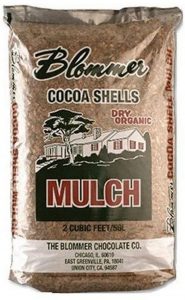 Cocoa bean mulch is popular with landscapers and gardeners for its pleasant odor and color. However, it is TOXIC for dogs! It contains a lethal ingredient called “Theobromine.” It smells like chocolate which can be tempting for some dogs. Avoid this mulch altogether if you have pets.
Cocoa bean mulch is popular with landscapers and gardeners for its pleasant odor and color. However, it is TOXIC for dogs! It contains a lethal ingredient called “Theobromine.” It smells like chocolate which can be tempting for some dogs. Avoid this mulch altogether if you have pets.
4. Aloe Vera:
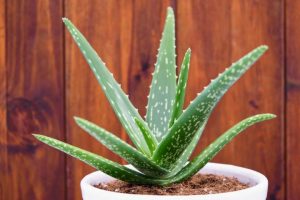
The sap from aloe vera, when ingested by your cat or dog, can cause an upset stomach which can lead to diarrhea, vomiting, tremors, and other mental effects.
5. Lilies:

There are over 90 species, but the ones that are harmful according to the ASPCA are Peaceful Lilies, Amaryllis, Autumn Cross, Palm Lilly or the Dracaena, Lily of Valley, Tiger Lilies, and Stargazers. Exposure can lead to vomiting, diarrhea, and weakness even causing kidney failure.
6. Dieffenbachia (Dumb Cane):
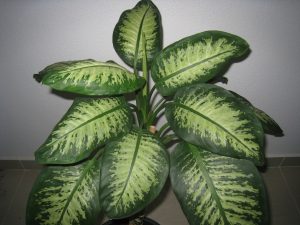
A green plant with white spots and flecks. When ingested, your pet may vomit, have excessive drooling, difficulty swallowing, or irritation in his mouth. The plant is not only harmful to our pets but humans as well.
The daisy contains sesquiterpene which causes excessive salivation, vomiting, and diarrhea, and can lead to uncoordinated movement.
Hydrangeas are poisonous to our pets.. They contain cyanogenic glycosides, which can cause lethargy, depression, vomiting, diarrhea, and an increase in heart rate and body temperature.
9. Jade Plant:
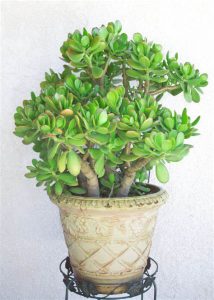
Also known as the rubber plant – is part of the Crassulaceae family, and all the plants in this family are poisonous to dogs and cats. Consuming this plant causes vomiting, lethargy, abdominal pain, weakness, and depression. In extreme cases it can lead to a slowed heart rate and convulsions.
10. Ivy:

This is known for its beautiful and bright leaves. It can cause skin irritation in humans, but with pets – vomiting, abdominal pain, hyper-salivation and diarrhea.
Common signs of your pet accidently eating this will lead to vomiting, diarrhea, weakness, blindness, cardiac failure, and depression.
12. Tomatoes:  A popular fruit, but surprisingly toxic to our pets! The green parts of the tomato such as the leaves and the stem contain a chemical called solanine which is poisonous, especially to puppies and kittens. Common signs of ingestion are hypersalivation, loss of appetite, weakness, dilated pupils, and slowing of heart rate.
A popular fruit, but surprisingly toxic to our pets! The green parts of the tomato such as the leaves and the stem contain a chemical called solanine which is poisonous, especially to puppies and kittens. Common signs of ingestion are hypersalivation, loss of appetite, weakness, dilated pupils, and slowing of heart rate.
Like the tomato plant- the stems, leaves, and seeds of a cherry plant our toxic to both dogs and cats.
14. Mistletoe:

Just one bite has the potential to make cats or dogs sick – usually in the form of vomiting followed by lethargy. If your pet continues to vomit-it is time for them to see a veterinarian. Remember: If you suspect poisoning, take away food and water for a few hours to allow their stomach to settle.
15. Marijuana (cannabis):  If you pet accidently ate this, the symptoms you most likely to see include vomiting, sleepiness or excitation, hyper salivation, dilated pupils, low blood pressure, and more serious conditions like seizures, coma, and death.
If you pet accidently ate this, the symptoms you most likely to see include vomiting, sleepiness or excitation, hyper salivation, dilated pupils, low blood pressure, and more serious conditions like seizures, coma, and death.
You might be wondering why compost is bad for your furry friend. After all, dogs eat crazier stuff than food scraps. The danger with compost lies in a fungus called tremorgenic mycotoxin that can occur in moist, decomposing food. Poisons from molds can cause neurological symptoms such as tremors and seizure that can last hours or days if not treated rapidly. Other symptoms include vomiting, hyperactivity, depression, coma, behavior alterations, increase in heart rate, and buildup of fluid in the lungs. If you have a compost pile-make sure it is fenced off and away from both pets and children.
17. Rose and plant fertilizers: 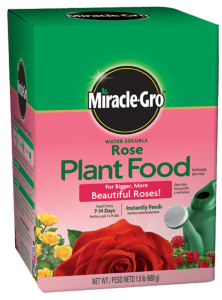 Some of these fertilizers contain disulfoton or other types of organophosphates (OP). As little as 1 teaspoon of 1% disulfoton can kill a 55 lb dog, so be careful! Organophosphates, while less commonly used, can result in severe symptoms including S.L.U.D. (Salivation, Lacrimation, Urination, and Defecation) symptoms, seizures, difficulty breathing, hyperthermia, etc. In some cases, it can be fatal!
Some of these fertilizers contain disulfoton or other types of organophosphates (OP). As little as 1 teaspoon of 1% disulfoton can kill a 55 lb dog, so be careful! Organophosphates, while less commonly used, can result in severe symptoms including S.L.U.D. (Salivation, Lacrimation, Urination, and Defecation) symptoms, seizures, difficulty breathing, hyperthermia, etc. In some cases, it can be fatal!
Slug and snail baits are commonly used on the West coast and in warm-weather conditions, and are available in a variety of forms (pellets, granular, powder, and liquid). The active ingredient is typically metaldehyde, which is toxic to all species (particularly dogs). When ingested, metaldehyde results in clinical signs that resulted in the nickname “shake and bake.” Within 1 to 2 hours of ingestion, clinical signs of salivation, restlessness, vomiting, and incoordination are seen, which then progress to tremors, seizures, and secondary severe hyperthermia. Seeking a veterinarian immediately is recommended.
We love our pets and would never knowingly expose them to life-threatening dangers. Most pet deaths by poisoning occur because people just aren’t aware of the many toxic substances we all have in and around our homes. Knowing what these substances are and eliminating exposure to these items will help ensure that our pets live long and happy lives! When in doubt, don’t take any chances – call your vet or an emergency veterinary clinic right away.
PET POISON HELPLINE: 1-800-213-6680

